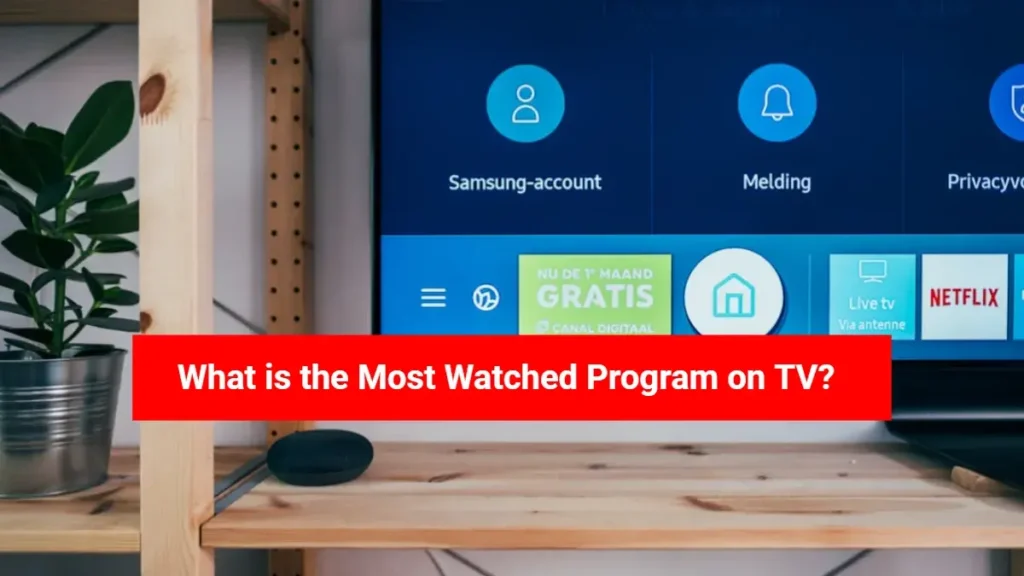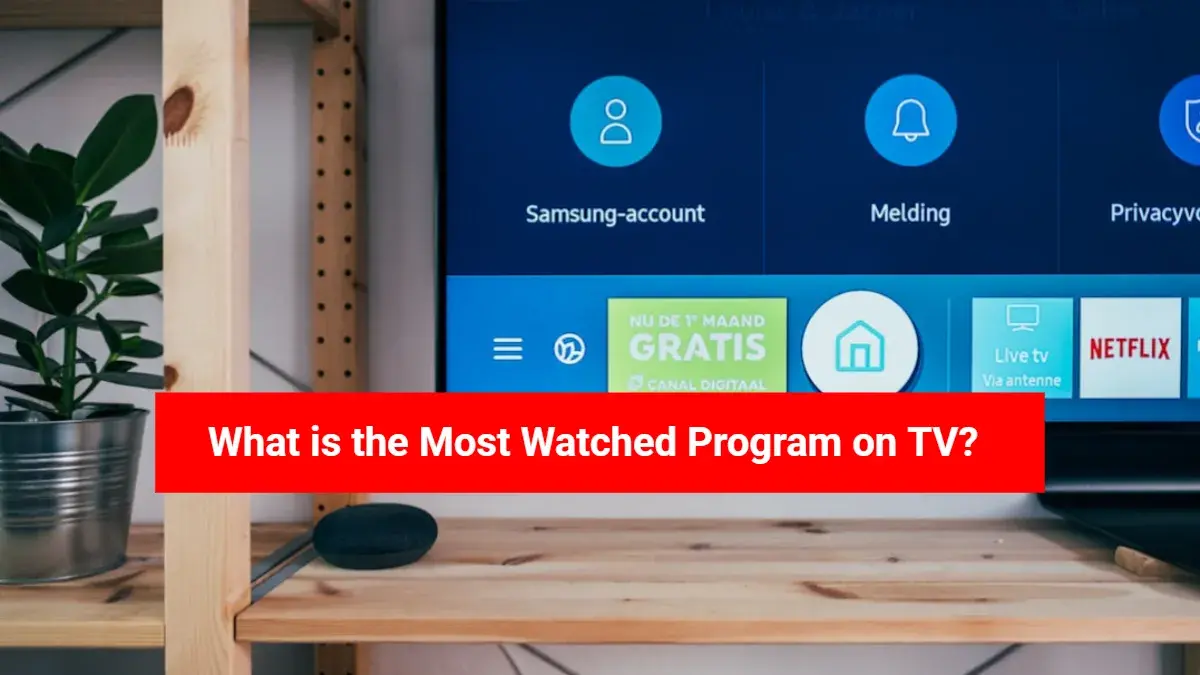What is the Most Watched Program on TV?
In the world of entertainment, the most watched program on TV often includes live events like the Super Bowl or popular reality shows. These programs dominate viewership, attracting millions. Whether it’s sports or entertainment, the most watched program on TV captures global attention and keeps audiences hooked.

Table of Contents
Television has long been a primary source of entertainment and information. With the rise of streaming platforms, one might think that traditional TV programming is no longer as relevant, but in fact, some television programs still dominate the ratings and draw millions of viewers worldwide. So, what is the most watched program on TV today?
In this article, we will explore some of the most popular TV programs, examining both global phenomena and regional favorites that have captured the hearts of audiences. By understanding the key factors behind a show’s success, we can better appreciate why certain programs rise above the rest.
The Evolution of Television Ratings
Before diving into the current most-watched programs, it’s important to understand how television ratings work. Television ratings measure the number of viewers watching a particular program at a given time. Historically, networks relied on Nielsen ratings in the United States, a system that tracked a sample group of households’ viewing habits. Now, with the growth of digital and online platforms, tracking viewership has become more sophisticated, but the core concept remains the same.
TV programs that attract millions of viewers regularly are often referred to as “hit shows.” These shows can span a wide variety of genres, from scripted drama and comedy to reality TV, news programs, and sports events.
What Factors Contribute to a Show’s Popularity?
Several factors contribute to the success of a TV program. These include:
Compelling Content: Programs that offer unique or high-quality content tend to attract a large audience. Whether it’s a gripping drama, a hilarious comedy, or a thrilling competition, people are drawn to content that excites, entertains, or educates.
Star Power: Well-known actors, hosts, or celebrities can make a huge difference in drawing in viewers. Big names can guarantee a certain level of attention and viewership right from the start.
Cultural Relevance: Shows that resonate with current trends, issues, or cultural movements tend to become more popular. Reality shows, for example, often reflect current societal interests.
Strong Fan Base: Shows that build a loyal following through word-of-mouth, online discussions, and social media often see higher ratings. A passionate fan base can contribute to a program’s longevity.
Timing and Consistency: The timing of a show’s airing is important. Programs that air during prime time or special events can achieve higher viewership. Additionally, consistent programming, such as weekly episodes, creates routine engagement with viewers.
The Most Watched Program on TV: Global Phenomena
In terms of sheer global popularity, sports events like the Super Bowl, the FIFA World Cup, and the Olympic Games are some of the most watched programs on TV. These events draw audiences from all corners of the world, bringing together diverse demographics. The excitement, competition, and global significance of these events make them unmissable for millions.
However, if we are looking at regular, non-sporting programming, news programs and reality shows dominate the viewership charts. For example, programs like “The Voice,” “American Idol,” and “Survivor” consistently attract large audiences year after year. Reality shows have become a staple of modern TV, combining entertainment with the opportunity for audiences to relate to ordinary people in extraordinary situations.
The Popularity of Reality TV
One of the major contributors to the most-watched TV programs is reality television. Shows like “The Voice,” “Big Brother,” and “The Bachelor” continue to break viewership records, primarily due to their format, which involves real people competing or living in unique circumstances. The authenticity of these programs (despite their often scripted elements) gives audiences a sense of connection, which keeps them coming back.
The Voice, in particular, is a global sensation. The competition, involving aspiring singers and celebrity coaches, has found success in multiple countries, including the United States, the UK, and Australia. It consistently ranks among the most watched TV programs, thanks to its engaging content and star-studded panel of coaches.
The Role of TV Series and Dramas
Another category of programs that consistently tops the viewership charts are TV series and dramas. While cable TV has seen a decline in recent years, many blockbuster shows on streaming platforms such as Netflix, Amazon Prime, and Hulu have become major cultural events. For instance, shows like “Game of Thrones,” “Stranger Things,” and “The Crown” garnered millions of viewers and dominated discussions on social media.
On traditional TV, dramas like “NCIS,” “Grey’s Anatomy,” and “This Is Us” continue to draw large audiences, especially in prime-time slots. These shows offer a mix of emotional storytelling, character development, and suspense that keeps viewers coming back for more.
The Dominance of News Programs
When discussing what is the most watched program on TV, it’s impossible not to mention news programs. Across the world, news networks such as CNN, BBC, and Fox News attract millions of viewers daily. While the content may vary, news programs are a vital source of information for many, particularly during significant events such as elections, crises, or natural disasters.
Programs like “60 Minutes” and “CBS Evening News” have maintained their positions as some of the most-watched TV programs due to their credibility and commitment to in-depth reporting. For a large portion of the population, news programs serve as their primary connection to the outside world.
The Impact of Live Events
One thing that traditional TV still holds over streaming services is its ability to broadcast live events. Major award shows like the Oscars, the Grammys, and the Golden Globe Awards attract millions of viewers. These events not only feature entertainment and awards but also have become social and cultural touchpoints. They serve as a reminder of how live events can bring people together, generating buzz both on TV and across social media platforms.
The Super Bowl remains the undisputed king of live televised events. Year after year, it attracts an audience of over 100 million people, with viewership peaking during the halftime show and the commercials. The cultural relevance of the Super Bowl, both as a sporting event and as a media spectacle, makes it one of the most-watched programs on TV.
The Decline of Traditional TV and the Rise of Streaming
While we have discussed some of the most watched programs on TV, it is important to acknowledge the changing landscape of television. With the rise of streaming services like Netflix, Amazon Prime, and Disney+, many viewers are now opting to watch content on-demand, bypassing traditional cable and satellite TV altogether. This shift has resulted in a decline in the ratings of many established TV programs.
However, certain traditional shows still maintain their massive viewership, especially if they continue to air on network TV during prime time. While streaming services are becoming a dominant force in entertainment, the large-scale viewership of events like the Super Bowl and the Olympics show that live programming still holds significant power in the TV industry.
